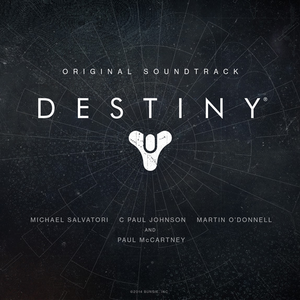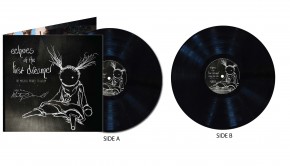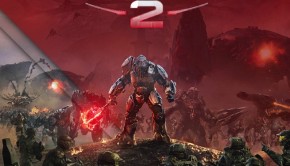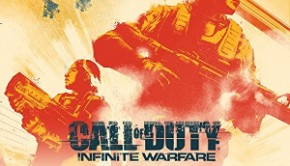Destiny Original Soundtrack
 |
Album Title: Destiny Original Soundtrack |
| Record Label: Bungie Music Publishing |
|
| Catalog No.: N/A |
|
| Release Date: September 26, 2014 |
|
| Purchase: Download at iTunes |
Overview
While Destiny has received some on-target criticism for being mildly half-baked, particularly in terms of plot and location development, the gameplay is dazzling. The combination of tantalizing graphics and visuals, wonderfully smooth character movement, and heart-pounding combat sequences help to carry the game towards its more positive reviews, and rightly so. The game is an amalgam of first-person shooters, Halo-style, laced with some unusually stimulating melee action and imbued with MMO qualities. The soundtrack, thankfully, falls under the positive category of Destiny’s features. Perhaps not all of the tracks translate to album, but the majority does so spectacularly, and in-game, the music provides the atmosphere necessary for the mystery, the terror, and the wonder that Destiny aims to evoke.
Long-time Bungie sound director Martin O’Donnell teamed up with long-time collaborator Michael Salvatori (who, despite composing for the Bungie since 2001, only became an employee of Bungie in 2011), assistant C Paul Johnson, and Paul McCartney, of the Beatles fame, to create the soundtrack of Destiny. The soundtrack is a complete one, reaching over two hours in its full length, and thorough, meeting many of my own, personal “must-haves” in orchestrated soundtracks for epic-style movies and games such as Destiny. My list includes live recordings, thematic elements woven into several tracks to create a cohesive musical structure, and perhaps most importantly, a mixture of instrumental textures, so that the listener is not left gasping for air after going through an entire album of full orchestra. Destinymeets those requirements and more; O’Donnell, generally credited as the lead composer, brings a remarkably fresh sound to the game, bringing live instruments, both soli and solo, a spread of electronics, and a conservatively-utilized chorus to accent the most dramatic moments.
Body
The game’s opening sequence introduces the Traveler, a mysterious entity that pioneers the technological development of the human race, through a cutscene that shows off the graphics and preparation of one of the extra-terrestrial planets. Under O’Donnell’s lead, the soundtrack begins classically, with a horn solo that last almost thirty seconds before it’s met with a series of strings and a solo cello, and finally a barrage of brass. The music lets up again for a vocal solo, a harp, and some delicate percussion, introducing the full range of instrumentation featured in the Destiny soundtrack. The climactic close features a swell of strings backed by arpeggiated celli, and cut off by the horn solo returning a final time. In case the listener mistakenly believes that this soundtrack will be a classical one, however, O’Donnell follows the first track with “The Fallen,” during which the player first encounters the game’s villains of the same name. The noisescape does not completely banish the orchestra; the horn has returned, but this time, it’s accompanied by white noise and unnaturally high, dissonant strings, setting the listener’s teeth on edge. The earlier percussion has been switched out for a drumset that accompanies both the horns and the dissonance with a familiar, rock-style rhythm. The music doesn’t translate as well to album as it does in context.
In any soundtrack I listen to and genuinely enjoy, there is always a singular moment during which my appreciation for how much the music encourages the in-game action grows drastically. This moment for Destiny was “The Last Array,” during one of the first seriously difficult missions of the game. The track plays as slews of 40-50 antagonists attack the player, who must ward them off using a learned combination of both melee and ranged combat. The accompanying music is simultaneously bright and militant, introduced by a piercing percussive rhythm accented with syncopated, staccato strings. The horns, while present throughout the majority of the piece, swell as the piece continues to reach a triumphant burst of notes amid the ostinato percussion.
One particularly intriguing – and appealing – aspect of O’Donnell’s score is the presence of what I saw as a percussive motif. While melodic themes certainly laced the soundtrack, the percussion played just a significant role as the melodic instruments. Many of the distinctive rhythms returned several times throughout the soundtrack; “First Challenge” brings a syncopated rhythm similar to that of “The Last Array,” but through a series of electronic pulses instead of percussion, at least initially. While the implementation of the rhythm becomes more dramatic as the piece continues, the rhythm itself does not change drastically. A constant element of the soundtrack is the syncopation in many of the pieces, in which the rhythmic pulses rarely take place directly on the beats of the piece. “Exclusion Zone” takes a different rhythmic motif, one that shows up earlier in “Dust Giants,” dragging out each pulse significantly enough so that it takes several listens to decipher the tempo of the piece from the very beginning. The moods of “Exclusion Zone” and “Dust Giants” vary; the latter is very driven, with a tattooed series of eighth notes appearing first sporadically and then more regularly. Eventually, the strange rhythm is countered by a snare, followed by a traditional drum set. The former is darker and more mysterious, with the opening instrument combining percussion and electronic sounds, and is eventually met with a chromatically descending choir occasionally dipping hesitantly into the main theme of Destiny, “The Traveler,” and quickly retreating back into the chromatics without ever completely losing the rhythm.
It is this element of syncopation that makes “Cabal Stomp” a distinctive track in Destiny’s score. The use of very heavy percussion is not all that unusual, in this soundtrack or any other, and certainly the location of the beats are generic, directly on each beat. In fact, the piece consists almost entirely of straightforward note divisions, lacking anything more complicated than an eighth note. Eventually the piece does become more syncopated as it continues, but only enough to emphasize the down beats even more significantly. However, because the prominent downbeats are so rare in the percussion of Destiny, what should be a fairly typical percussion piece becomes unusual and relatively interesting. The “Siege Dancers” is a mild variation of “Cabal Stomp,” maintaining an identical rhythm, albeit sped-up, but this time amid a more varied sub-rhythm. The piece is almost tribal in nature, but gives way to more nonconvential instrumentation, with electronics descending the chromatic scale, and a very slight variation on the melody.
That’s not to say all themes are percussive. “The Warmind” introduces a beautiful theme that places the dissonance O’Donnell uses so liberally at the forefront of the piece. The format of the piece is a unique cascade of key changes, each one playing the same motif, but with a different set of notes and through a different medium. The instrumentation is wonderfully versatile, with several instruments and instrumental sections being used repeatedly but through different formats. In one realization of the melody, the horns play the melody against a backdrop of percussion. In the first repeat, O’Donnell introduces strings to further break up the rhythm. In another, the exact same instrumentation is used, but in a higher octave. Eventually vocals are introduced, first singing the dominant melody, and later retreating to let the horns take over again. I wonder if O’Donnell set out to create a horn-centered soundtrack; if he did, then he certainly succeeded. The horns always seem to belt out during any major battle or Guardian location.
Several of the tracks on the album are excerpts from the much-delayed Music of the Spheres project. Separately recorded from the rest of the soundtrack in Abbey Road Studios, O’Donnell and Salvatori created some of the most musically-ambitious additions to the soundtrack here. An excellent example is “Excerpt from the Hope,” which introduces an unusually ecclesiastical melody. The piece opens with soaring waves of mellowed full orchestra sections. Eventually, the piece leads to an odd motif, which takes place between three notes that are each accompanied by constant intervals, creating an eerie pentatonic series of dyads. However, the motif is performed with what sounds like a church choir, complete with echoes and a slight blend of pitches between each note. The dissonance that accompanies every other note in the motif sounds like something out of an Eric Whitacre piece, bringing an oddly religious theme to the space-travel in Destiny. It is, after all, a central element of a game that involves jumps between planets, and the time spent in space should be spent with an element of reverence.
One big issue I often see with soundtracks created by a combined set of composers is a lack of continuity. For some reason, this soundtrack did not even remotely run into this problem. After playing the game for just a few hours, I was able to distinguish Destiny from any other score on my soundtrack playlists. I am curious to see a division of composer contributions. It seems the composers did not simply split up songs, with O’Donnell, Salvatori, and Johnson collaborating on most tracks. (McCartney’s contribution is a little clearer, as he apparently contributed melodic ideas to the opening theme, several of the Music of the Spheres pieces, and the ending ballad, which is absent here). However, a stronger understanding of how the musicians worked with the score and with each other would be hugely interesting to have. Either way, the combined talents of O’Donnell, Salvatori, Johnson, and McCartney were certainly effective.
“End of the Line” and “Excerpt 2 from The Rose” are two of the wonderful closing pieces in Destiny. While they share several motifs, they are executed differently, with “End of the Line” being a very faint nod to “The Warmind” with its dissonance and constant key changes, but with a refreshingly original array of strings. The harmonies in this piece are new in the album, and towards the end of any soundtrack, new harmonies are always welcome. The track uses a choir to fill the melody line, but the style of this choir is radically different from the majority of the choir in the soundtrack up to this point. The sound is very clear-cut and sharp, and while the other choral pieces involved a choir that could have been singing at the altar of a large cathedral in terms of acoustics and articulation, this choir is anything but ecclesiastical. The rock guitar doesn’t help. The piece is a joyous one, filled with unusually vivid harmonies (and very little dissonance), and constantly ascending keys. Again, however, like the unique “Cabal Stomp,” this track brings yet another new feel to the game, without completely abandoning all elements of Destiny’s music, as the rhythm is largely syncopated.
Another addition from the Music of the Spheres project, “Excerpt 2 from the Rose” opens with a series of arpeggios, quickly met with a choir of the same style of “End of the Line,” and by the same rhythmic pattern of strings that added that bright new harmony to “Line.” However, in this realization, the rhythm is far more driving and intensive, and less joyous. Some of the melody contains flavors of “Cabal Stomp,” but through a far more propelling instrumentation, texture, and tempo.
Summary
The soundtrack to Destiny is an extraordinary one. Whatever Bungie’s secret reasons were for firing Martin O’Donnell in April, it could not have been his musical ability and contributions. He certainly ended his career with Bungie on a musical high note. Through working closely with Michael Salvatori, C Paul Johnson, and Paul McCartney, he composed a solid epic score brought to life by the performances of the Northwest Sinfonia. It takes the listener on the same journey as the player through Destiny. On a side note, I hope that the soundtrack will one day receive the physical release it deserves and that the Music of the Spheres finally comes to fruition. Until then, the 138 minute soundtrack for Destiny can be purchased through most digital labels for a very reasonable 10 USD now.
Do you agree with the review and score? Let us know in the comments below!
4.5
Posted on November 15, 2014 by Emily McMillan. Last modified on November 15, 2014.














